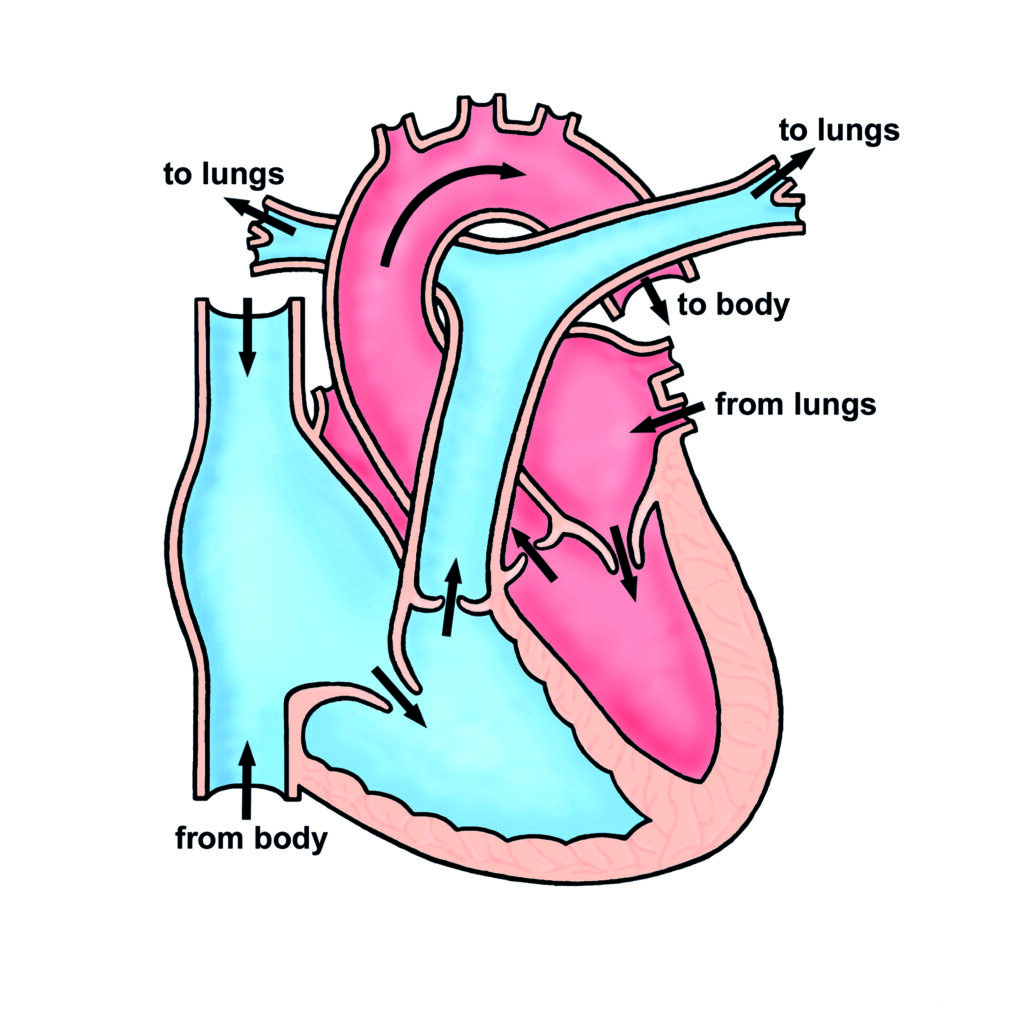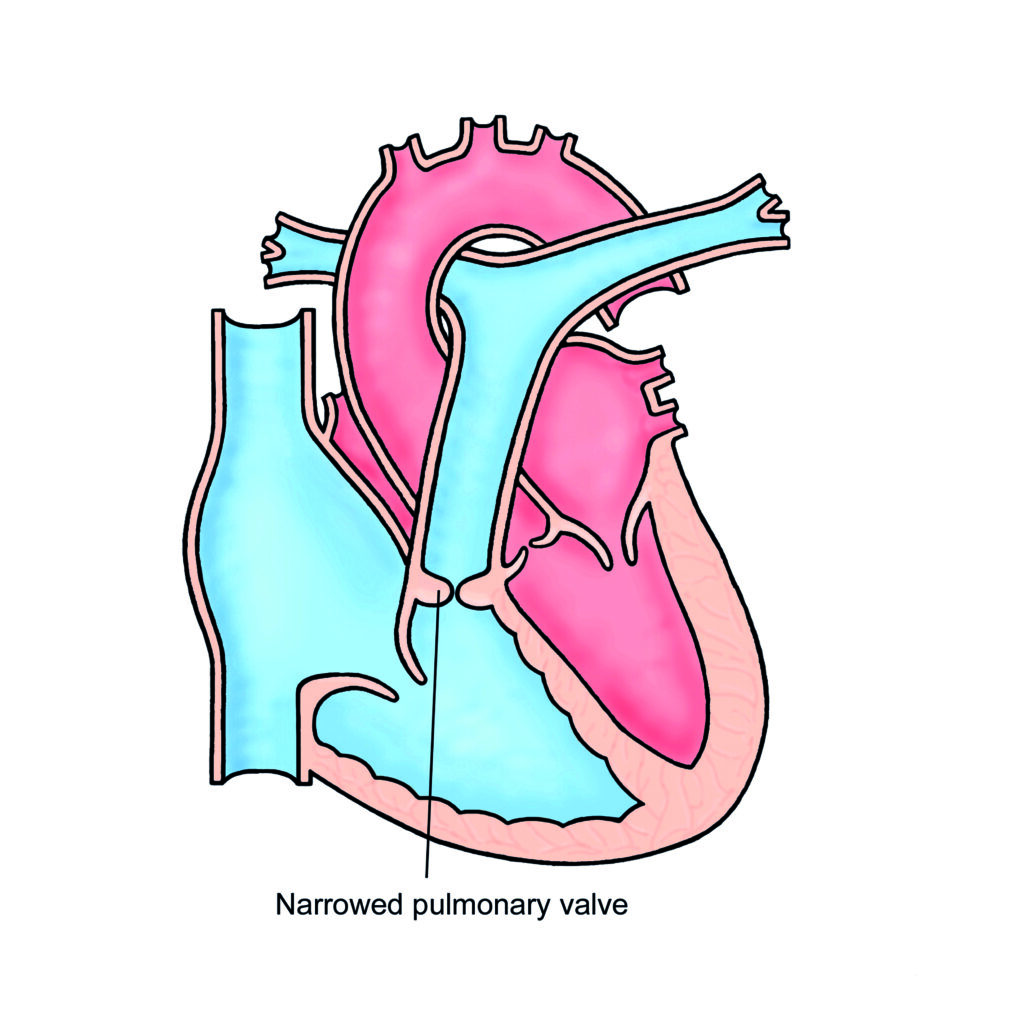This leaflet provides information for parents and carers about pulmonary stenosis in children and the management and treatment of this condition.
Pulmonary Stenosis
In this condition the valve letting blood flow from the heart to the arteries in the lungs is narrowed. In most cases it is not a serious problem.
In the normal heart, blood passes from the main pumping chamber on the right side of the heart (the right ventricle) to the artery feeding the lungs with blood (the pulmonary artery). When the valve letting blood out of the right ventricle (the pulmonary valve) is narrow the muscle of the right ventricle has to work harder than normal and the muscle gets thickened, just like other muscles in the body if they are worked hard. If the pulmonary valve is only mildly narrowed the heart copes very well, but if the narrowing is very severe the heart cannot pump normally, and this can limit how much exercise the child can manage and very rarely can even cause death if it is not treated.
Many children have mild pulmonary stenosis and do not need any treatment at all, but the valve can become narrower as the child grows, so check-ups in the outpatient clinic will be necessary even if the chid appears perfectly well.


Here’s a video of how Pulmonary Stenosis affects the heart circulation
Pulmonary Stenosis – YouTube transcript
this video explains a congenital heart
condition pulmonary stenosis you may
wish to view our video on the normal
heart function first the parts of the
heart that pumps blood to the lungs is
called the right ventricle
but passes from the right ventricle
through the pulmonary valve to the main
coronary artery which then divides into
right and left pulmonary arteries to
take blood to the right son left lungs
stenosis is an abnormality of the
Palmeri valve
the Palmeri valve opens to a blurred out
of the heart and then closes to prevent
blood leaking back into the heart in
pulmonary stenosis the valve doesn’t
open as well as it should and this can
mean at the heart has to work harder to
pump blood to the lungs
when the heart has to work harder over
time this can cause the most of the
right ventricle to become thicker to
nail it to pump more forcefully
when palmarosa gnosis is mild there’s
little obstruction to hood bein pumped
to the lungs the heart muscle does not
become thicker and treatment may not be
necessary when palmarosa gnosis is more
severe treatments may be required in
some cases surgeries performed to
improve the function of the valve in
other cases a Pomona balloon
valvuloplasty can be performed upon mone
balloon valvuloplasty is a keyhole
procedure in which a balloon is passed
through the heart to the pulmonary valve
where it is inflated the expansion of
the balloon forces the valve open a
potential consequence of treating Polish
nurses is that the Palmeri valve leaks
this is called pulmonary incompetence or
pulmonary regurgitation some of the
blood that had been pumped out of the
right ventricle to the pulmonary artery
leaks back into the right ventricle this
itself can have effects on the heart
usually over a long period of time
for more information on pondering
competence please view our separate
video
Tests
An ultrasound scan of the heart (“echocardiogram”) is required to look at the heart valve.
Treatment
If the valve is severely narrowed treatment will be needed. It is very rare to need open heart surgery.
Keyhole treatment
Most cases can be treated by stretching the narrow valve open with a balloon (called “balloon valvuloplasty”). This is done under general anaesthetic and involves passing a long tube with a collapsed balloon on the end of it (a balloon catheter) into the vein at the top of the leg and feeding it up into the heart and across the narrow valve. Using Xray pictures, the balloon is positioned in the narrow valve and is blown up, stretching the valve open.
The cardiologist will discuss the risks and potential complications of the procedure in clinic with you.
This is often performed as a day case or sometimes a one night’s stay in hospital is necessary. Sometimes if the narrowing is only partly relieved by the balloon the procedure may be repeated later.
Because the thickened heart muscle (due to the narrow valve) itself can cause some narrowing, it is not always possible to tell straight after the procedure exactly how successful it has been – sometimes we have to wait for a few weeks for the thickened heart muscle to return to normal.
In a small proportion of patients, the thickened heart muscle doesn’t return to normal and if this causes important narrowing inside the heart, surgery is needed to remove some of the muscle.
Surgical treatment
Sometimes the pulmonary valve cannot be stretched open using a balloon and open-heart surgery will be needed. If this is necessary, the surgeon will discuss the operation with you in detail including the risk and potential complications.
After the operation the child usually stays in hospital for about 5 days.
The long-term future
Children who have not needed any treatment by the time they are fully grown usually don’t ever need treatment for their pulmonary stenosis, but in rare cases the valve can become narrower in later adult life.
Children who have a good result from balloon stretching of the valve or surgery usually do not need any further treatment. However, after any kind of treatment for pulmonary stenosis, the pulmonary valve never works completely normally, and will leak to some extent (some of the blood pumped out of the heart to the lungs flows back into the heart through the valve). There is a small chance that some children might need surgery to replace or repair the valve in later life.
Here’s a video with an explanation of pulmonary incompetence (or pulmonary regurgitation) and its treatment by pulmonary valve replacement
Pulmonary Incompetence & Pulmonary Valve Replacement – YouTube transcript
this movie is about pulmonary
incompetence also called pulmonary
regurgitation and replacement of the
pulmonary valve the hearts right
ventricle pumps blood to the lungs
through the pulmonary arteries
as blood leaves the right ventricle it
passes through the pulmonary valve
the function of the pulmonary valve is
to prevent blood from returning to the
right ventricle from the pulmonary
artery
if the pulmonary valve leaks some blood
that’s been pumped out to the heart
returns from the pulmonary artery back
into the right ventricle and this is
called pulmonary incompetence or
pulmonary regurgitation there are a
number of possible causes of pulmonary
incompetence but it occurs most commonly
as a result of treatment of congenital
heart conditions such as tetralogy a
fallow or pulmonary stenosis you may
wish to view our separate movies on
these conditions the main effect that
the pulmonary incompetence has on the
heart if the leak is severe enough is to
cause the right ventricle to dilate
which means it becomes larger the heart
generally copes well with pulmonary
incompetence often for many years
however significant pulmonary
incompetence usually requires treatment
at some point and the treatment required
is replacement of the pulmonary valve
pulmonary valve replacement may require
open-heart surgery in which new valve is
sewn into place directly once the valve
has been implanted blood that is pumped
to the pulmonary artery no longer
returns to the right ventricle
it may be possible to implants a new
pulmonary valve in a keyhole technique
which avoids the need to open the chest
at an operation in the keyhole technique
a new valve is passed to the hearts
through the veins and is expanded once
it is in the correct position once a new
pulmonary valve is in place the right
ventricle usually becomes smaller
possibly returning to a normal size
regular follow-up is required after a
pulmonary valve replacement to check on
the function of the valve over time
you
General advice for the future
Most children with pulmonary stenosis, whether they have had treatment or not, lead completely normal lives and can exercise normally too.
Patients with pulmonary stenosis will be at a small risk of infection in the heart (called endocarditis), both before and after treatment. Such infections may be caused by infections of the teeth or gums. It is important to look after your child’s teeth and visit the dentist regularly (every 6-12 months). Ear or body piercing and tattooing are best avoided as they also carry a small risk of infection which may spread to the heart. For more information about endocarditis please see the link below: